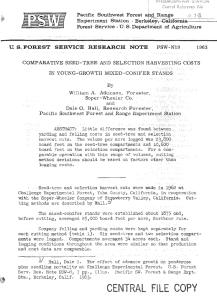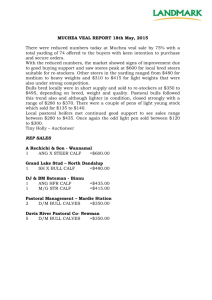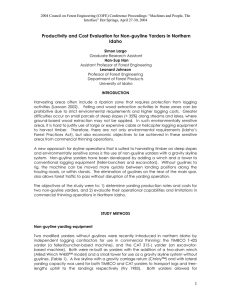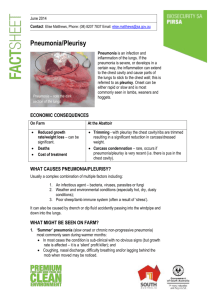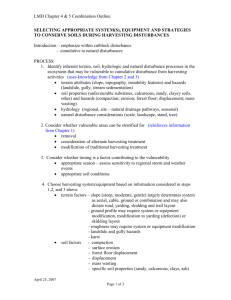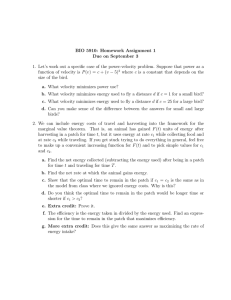Effects of Alternative Silvicultural Treatments on Washington
advertisement
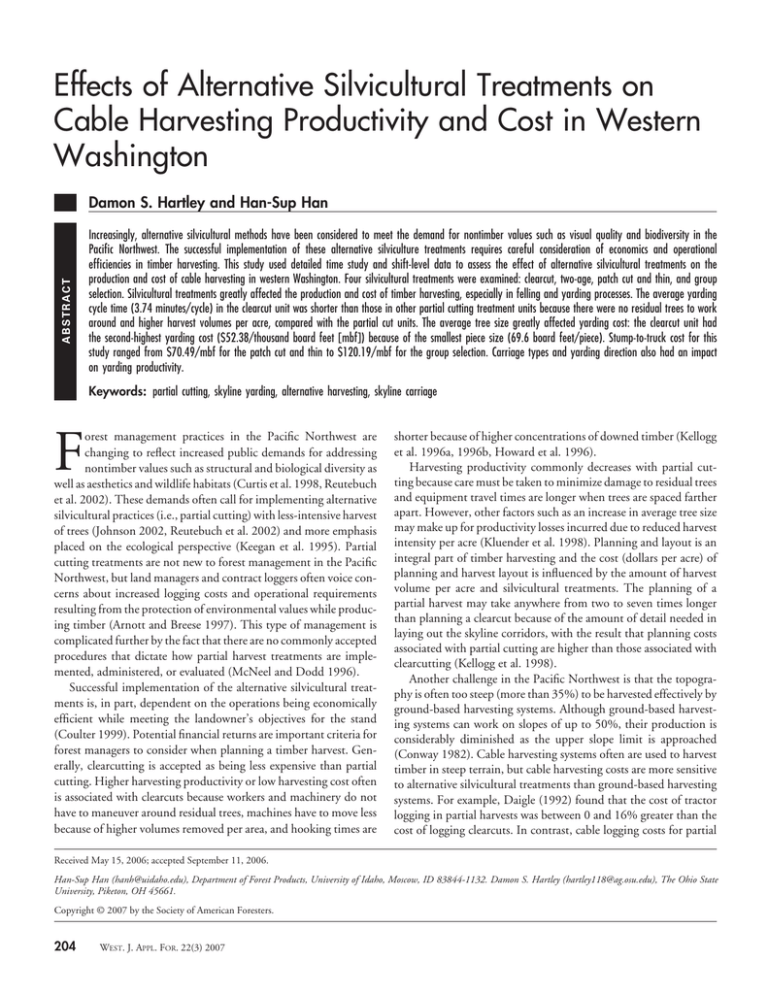
Effects of Alternative Silvicultural Treatments on Cable Harvesting Productivity and Cost in Western Washington ABSTRACT Damon S. Hartley and Han-Sup Han Increasingly, alternative silvicultural methods have been considered to meet the demand for nontimber values such as visual quality and biodiversity in the Pacific Northwest. The successful implementation of these alternative silviculture treatments requires careful consideration of economics and operational efficiencies in timber harvesting. This study used detailed time study and shift-level data to assess the effect of alternative silvicultural treatments on the production and cost of cable harvesting in western Washington. Four silvicultural treatments were examined: clearcut, two-age, patch cut and thin, and group selection. Silvicultural treatments greatly affected the production and cost of timber harvesting, especially in felling and yarding processes. The average yarding cycle time (3.74 minutes/cycle) in the clearcut unit was shorter than those in other partial cutting treatment units because there were no residual trees to work around and higher harvest volumes per acre, compared with the partial cut units. The average tree size greatly affected yarding cost: the clearcut unit had the second-highest yarding cost ($52.38/thousand board feet [mbf]) because of the smallest piece size (69.6 board feet/piece). Stump-to-truck cost for this study ranged from $70.49/mbf for the patch cut and thin to $120.19/mbf for the group selection. Carriage types and yarding direction also had an impact on yarding productivity. Keywords: partial cutting, skyline yarding, alternative harvesting, skyline carriage F orest management practices in the Pacific Northwest are changing to reflect increased public demands for addressing nontimber values such as structural and biological diversity as well as aesthetics and wildlife habitats (Curtis et al. 1998, Reutebuch et al. 2002). These demands often call for implementing alternative silvicultural practices (i.e., partial cutting) with less-intensive harvest of trees (Johnson 2002, Reutebuch et al. 2002) and more emphasis placed on the ecological perspective (Keegan et al. 1995). Partial cutting treatments are not new to forest management in the Pacific Northwest, but land managers and contract loggers often voice con­ cerns about increased logging costs and operational requirements resulting from the protection of environmental values while produc­ ing timber (Arnott and Breese 1997). This type of management is complicated further by the fact that there are no commonly accepted procedures that dictate how partial harvest treatments are imple­ mented, administered, or evaluated (McNeel and Dodd 1996). Successful implementation of the alternative silvicultural treat­ ments is, in part, dependent on the operations being economically efficient while meeting the landowner’s objectives for the stand (Coulter 1999). Potential financial returns are important criteria for forest managers to consider when planning a timber harvest. Gen­ erally, clearcutting is accepted as being less expensive than partial cutting. Higher harvesting productivity or low harvesting cost often is associated with clearcuts because workers and machinery do not have to maneuver around residual trees, machines have to move less because of higher volumes removed per area, and hooking times are shorter because of higher concentrations of downed timber (Kellogg et al. 1996a, 1996b, Howard et al. 1996). Harvesting productivity commonly decreases with partial cut­ ting because care must be taken to minimize damage to residual trees and equipment travel times are longer when trees are spaced farther apart. However, other factors such as an increase in average tree size may make up for productivity losses incurred due to reduced harvest intensity per acre (Kluender et al. 1998). Planning and layout is an integral part of timber harvesting and the cost (dollars per acre) of planning and harvest layout is influenced by the amount of harvest volume per acre and silvicultural treatments. The planning of a partial harvest may take anywhere from two to seven times longer than planning a clearcut because of the amount of detail needed in laying out the skyline corridors, with the result that planning costs associated with partial cutting are higher than those associated with clearcutting (Kellogg et al. 1998). Another challenge in the Pacific Northwest is that the topogra­ phy is often too steep (more than 35%) to be harvested effectively by ground-based harvesting systems. Although ground-based harvest­ ing systems can work on slopes of up to 50%, their production is considerably diminished as the upper slope limit is approached (Conway 1982). Cable harvesting systems often are used to harvest timber in steep terrain, but cable harvesting costs are more sensitive to alternative silvicultural treatments than ground-based harvesting systems. For example, Daigle (1992) found that the cost of tractor logging in partial harvests was between 0 and 16% greater than the cost of logging clearcuts. In contrast, cable logging costs for partial Received May 15, 2006; accepted September 11, 2006. Han-Sup Han (hanh@uidaho.edu), Department of Forest Products, University of Idaho, Moscow, ID 83844-1132. Damon S. Hartley (hartley118@ag.osu.edu), The Ohio State University, Piketon, OH 45661. Copyright © 2007 by the Society of American Foresters. 204 WEST. J. APPL. FOR. 22(3) 2007 Table 1. Stand description and harvest volume in each silvicultural treatment. Treatment Area (ac) Mean slope (%) Mean dbh (in.) Preharvest density (TPA) Residual density (TPA) Volume per acre preharvest (mbf/ac)3 Volume per acre removed (mbf/ac) Clearcut Two-age Patch cut and thin Group selection 26 40 110 58 38 49 40 43 15.4 16.9 19.6 16.4 214 137 171 218 0 17 80 110 28.8 35.6 42.7 31.8 28.8 19.9 18.6 10.7 TPA, trees per acre. cutting were 19 and 4% above clearcutting costs. He suggested that several factors contributed to the difference in the increase in cable logging costs, including the large amount of time spent during cor­ ridor changes and the large labor inputs required for yarding activ­ ities (i.e., typically three to four people are directly related to yarding activities in a cable logging). Increased number of landing and road changes and smaller turn sizes also contribute to higher cable log­ ging costs in a partial cutting (Hochrein and Kellogg 1988). Eco­ nomic concerns become greater when alternative silvicultural treat­ ments are implemented using cable systems because these systems have higher costs than ground-based harvesting systems in a partial harvesting (Daigle 1992). Implementing alternative silvicultural systems in coastal conifer stands of the Pacific Northwest using cable systems is being consid­ ered more frequently, and there is a need to enhance our knowledge of how to efficiently and economically implement alternative har­ vesting practices. The objectives of this study were to compare the productivity and cost of cable harvesting among four different silvi­ cultural treatments and to identify what factors influence them. Study Area and Methods Four different silvicultural treatments were located on a 242-ac study area in the Capitol State Forest in Olympia, Washington (latitude, 46.85° N; longitude, 123.15° W). The stands were pri­ marily (89 –97%) stocked with Douglas-fir (Pseudotsuga menzesii), but also supported small components of western hemlock (Tsuga heterophylla), western red cedar (Thuja plicata), red alder (Alnus rubra), and bigleaf maple (Acer macrophyllum). The average dbh of the merchantable (i.e., conifer) species was 19 in. The elevation of the site is approximately 500 ft above sea level and the slope ranged from 15 to 57%. All cutting units were located outside of riparian management areas and were not required to leave buffers. Table 1 summarizes the mean site conditions for each of the four silvicul­ tural treatments. These treatments include • Clearcut. Even-aged prescription that removed 100% of trees in the harvest unit. Because clearcutting is the traditional and most common harvesting practice in this area, we have chosen to use it as the reference treatment for this study. We will use this reference as the basis of all comparisons between silvicultural treatments. • Two-age. Uneven-aged prescription, in which approximately 15 trees/ac are retained until the next rotation. • Patch cut and thin. Uneven-aged prescription that removed about 20% of the overstory, in patches of 1.5–5 ac with thin­ ning in between the openings, resulting in a stand that contains five separate age classes. The patch cut and thinning operations were not separated to analyze the overall effect of this type of treatment. Table 2. Felling and processing methods used in each silvicultural treatment. Silvicultural treatment Clearcut Two-age Patch cut and thin Group selection a Felling methoda Mechanical (100%) Manual (100%) Manual (67%) Mechanical (33%) Manual (33%) Mechanical (67%) Processing location Prebunching logs or trees Landing Stump/landing Stump/landing Yes No No Stump/landing No Value in parentheses indicates percentage (by area) of the felling method used. • Group selection. Similar to patch cut and thin except the open­ ings are limited to less than 1.5 ac that are scattered over the harvest unit. One logging contractor conducted all four silvicultural treat­ ments. The contractor was familiar with the use of cable harvesting systems in partial cutting operations and he had been performing partial harvest using these systems for 10 years. Felling was done either by a Timbco 445-D feller-buncher with a Quadco (Prince George, BC, Canada) hot saw head for flat or moderate slopes (less than 40%), or by a contract faller using a Stihl 064 chainsaw (Oceana West Industrial Park, Virginia Beach, VA) with a 34-in. bar for steep slopes (more than 40%). Both manual and mechanical felling methods were used in the group selection and patch cut, with the mechanical felling used in the thinning sections and manual felling was used in the clearcut patches. The clearcut unit was felled mechanically, and the two-age unit was felled manually (Table 2). Yarding was done using a Washington 78SL swing yarder (Trican Machinery, Ltd., New Westminster, BC, Canada) run by a crew of four with 5–30 years of experience: a yarder operator, a rigging slinger, and two choker-setters. The yarder had a 47-ft tower and was capable of yarding distances of 1,800 ft. The yarder was used in different configurations (standing and running skyline sys­ tems and uphill and downhill yarding) and with an assortment of carriages to facilitate yarding of the harvest units (Table 3). The equipment configurations were determined by the contractor, in accordance with his views on the most productive setup for the site. During yarding three carriage types were used: Eagle Eaglet motor­ ized clamping carriage, a mechanical slack pulling (MSP) carriage and a grapple carriage. The MSP carriage and the grapple carriage were used in downhill yarding situations in one of the clearcut patches with a running skyline setup. For material smaller than 17 in., large-end diameter, whole trees were yarded to the landing where trees were processed with an excavator-based Cat 320D with a Fabtec (Menomnee, MI) processing head in all units. All material larger than a 17-in. small-end diameter was processed at the stump using a chainsaw. A Link-Belt heel boom loader was used to load tree length logs onto the trucks at landing. WEST. J. APPL. FOR. 22(3) 2007 205 Table 3. Yarder configuration, carriage type, yarding direction, and average yarding distance for each silvicultural treatment unit. Silvicultural treatment Clearcut Two-age Patch cut and thin Group selection a b Skyline yarding configuration Standing Standing Standing/ running Standing Yarding distance (ft) Carriage type a Motorized Motorizeda Motorized,a MSP,b grapple Motorizeda Yarding direction Mean Range SD Uphill Uphill Uphill/downhill Uphill 315 412 425 404 50–590 75–580 15–625 75–700 119.39 143.53 168.92 158.96 Motorized slack pulling carriage. MSP carriage. A detailed time study was performed on the yarding phase of the operation for each silvicultural unit between May and August of 2002. All the productive elements and delays were measured to develop predictive equations for average cycle time for yarding op­ erations. The productive yarding cycle was divided into six ele­ ments: outhaul, lateral out, hooking, lateral in, inhaul, and unhook­ ing. The elemental times in seconds were collected using a Husky fex21 field computer (Lexington, KY), with the Time Study Data Logger program (Itronix, Spokane Valley, WA) (Wang 2001). Along with the elemental times, independent variables also were collected and related to the average yarding cycle time models. The independent variables collected were yarding distance, lateral distance (except for when grapple yarding was used in the patch cut and thin unit where lateral distance was not collected), number of pieces per cycle, carriage type, and yarding direction. Delays in the productive cycle were recorded also in three categories: (1) operational— downtime during the cycle such as hang-ups, losing logs, decking problems, and others; (2) mechanical— downtime caused as a result of machine failure; and (3) personal— downtime caused for other than mechanical or operational reasons. Shift-level data are the daily production information of a ma­ chine or person per shift recorded by each operator at the end of the day throughout the operation. A time log was kept on all the ma­ chines for the entire harvest so that the detailed information could be compared with the daily production, to make sure that there were no errors made. No detailed time study data were collected for felling, processing, and loading. Shift-level data were used to esti­ mate production rates for these activities. The daily production data for each piece of equipment were used to derive a cost per unit of volume for each piece of machinery on each harvesting unit. The data collected in the detailed time studies were entered into a Microsoft Excel spreadsheet, where an initial screening of data was performed. Outliers were screened and removed from the data set if they were more than 3 SDs from the mean. After the outliers were removed, the data were transferred to SAS version 8.02 (SAS 2001) where multivariate ordinary least squares regression analysis was preformed to develop models of delay-free cycle time. Tree and log size information was calculated using the preharvest cruise and scal­ ing data. The scaling data were obtained from the mill to which the logs were taken, where the logs were scaled according to the westside Scribner log rule. Logs were identified by truck scale tickets and were able to be differentiated by sale unit. The scaling data were used to determine average volume per piece for each unit and also the weighted average was used to determine average piece size for the sale. Machine rates were calculated for each machine that was used in the harvesting of each of the study units. The machine rates were calculated using the method outlined by Miyata (1980). Several assumptions were made to calculate machine rates, and they are 206 WEST. J. APPL. FOR. 22(3) 2007 Table 4. Assumptions used for machine rate calculations. Assumption Value SMH/yr Salvage value Interest, insurance, and tax Repair and maintenance Diesel price Fuel consumption Oil and lube cost Labor Economic lives Yarder Loader Processor Feller-buncher 2000 SMH/yr 20% of purchase price 15% of avgerage annual investment 60% of annual depreciation $1.68/gal 0.027 gal/hp-hr 37% of fuel cost Rates for western Washington 7 yr 7 yr 5 yr 5 yr summarized in Table 4. The machine rates for all machinery are listed in Table 5. For this study the yarder had the highest total cost per scheduled machine hour (SMH) because of high labor cost associated with a four-person crew. Results and Discussion Felling, Processing, and Loading Mechanical felling productivity varied greatly among silvicul­ tural treatments because of the differences in density of residual standing timber and felling methods (Table 6). Mechanical felling was used in the clearcut unit as well as the thinning sections of the patch cut and thin and group selection units. The average produc­ tion rates of the mechanical felling were not statistically different in the patch cut and group selection units with production rates of 32.4 trees/SMH and 28.0 trees/SMH, respectively, and 65.7 trees/SMH in the clearcut. Mechanical felling costs were 176% higher in the partial cutting areas ($17.74/thousand board feet [mbf]) than in the clearcut unit ($6.42/mbf). The cost per mbf was calculated by multiplying the trees per hour production rate by the average standing tree volume and dividing the machine rate for the felling system by that product. Manual felling productivity was ap­ proximately 12.01 trees/SMH (or $15.78/mbf) in the clearcut sec­ tions of the patch, group selection, and two-age treatments. It was expected that manual felling production would have decreased also because of the care necessary to avoid hang-ups and undue damage to the residual stand (Kellogg et al. 1996b). Felling productivity, however, was not affected because of the high fraction of trees felled in the sections where manual felling was used. In the calculation of felling cost, an average tree volume of 263.41 board feet (bd ft) was used, which was estimated from the presale cruise. Processing productivity was consistent throughout all the silvi­ cultural treatment units because processing occurred independently from the yarding activities. There were no processing production Table 5. Breakdown of machine rates ($/SMH) for each machine including labor. Machine Crew size (persons) Yarder Loader Processor Feller-buncher Chainsaw 4 1 1 1 1 Table 6. method. Manual Operating cost Labor including benefits Total cost . . . . . . . . . . . . . . . . . . . . . . . . . . . . . . . . . . . . . . .$/SMH . . . . . . . . . . . . . . . . . . . . . . . . . . . . . . . . . . . . . . . 15.96 6.53 113.65 146.14 22.88 13.55 30.45 66.88 61.31 29.12 35.45 125.88 43.89 28.62 34.58 107.09 0.67 0.86 52.55 54.08 Mean felling production (trees/hr) by unit and felling Felling method Mechanical Fixed cost Silvicultural treatment Hourly production (no. trees/SMH) Clearcut Patch cut thinning section Group selection thinning section Two-age Group and patch clearcut groups 65.72a 28.02b 32.38b 12.05c 13.24c Letters denote mean groups that are different between treatment at a = 0.05, using Tukey’s HSD. a,b,c data collected from this study, and we used the processing produc­ tion information from a previous study that used a similar processor in comparable tree sizes (Coulter 1999). The processing production rate used in the cost calculation was 11.45 mbf/SMH, which re­ sulted in a unit processing cost of $10.99/mbf. Log trucks were loaded from a cold deck, by a loader dedicated to loading only, resulting in a consistent production in loading for all the silvicultural treatment units studied. On average, five trucks were loaded per day with an average payload of 4.276 mbf/truck load. The hauling dis­ tance to the mill was 250 mi one way, and each truck made only one trip per day. This resulted in a loading cost of $25.03/mbf. Skyline Yarding Yarding Cycle Time The shortest average cycle time was observed in the clearcut unit (3.33 minutes), followed by the patch cut (4.23 minutes) and twoage (4.44 minutes), and the group selection (4.88 minutes) had the longest average cycle time (Figure 1, Table 7). The outhaul time was relatively similar throughout the treatments, with significant differ­ ences between the two-age and patch cut; and the clearcut and group selection were caused by the differences in the external yarding dis­ tance of each unit.The time spent pulling cable laterally was signif­ icantly higher in the two-age unit (46.61 seconds/cycle; P < 0.0001). This unit had a steeper ground slope than the other units and a large amount of logging slash on the ground, which resulted from processing large trees at the stump. The slash interfered with the choker-setter’s movement. Hooking time was the shortest for the clearcut and the two-age units (clearcut, 42.88 seconds/cycle; two-age, 47.69 seconds/cycle. The abundance of timber on the ground, timber mechanically felled and bunched (clearcut), and large trees (two-age) attributed to the quick hooking time. Time for lateral-in to the carriage was influenced by residual trees and the felling method. The two-age and group selection units, which required the greatest amount of yarding through standing timber, had significantly higher cycle times for lateral-in than clearcut and patch cut (Tukey’s honestly significant difference [HSD], P < 0.001). The logs and trees in the group selection and two-age units had to be worked around residual trees during the lateral– cable-in process, slowing the process of returning the cable to the carriage. In the patch cut, the trees in the single tree selection thinning area were mechanically felled and placed in bunches near the skyline corridors to facilitate the lateral-in process. In the areas that were grapple yarded the lateral distance was recorded as 0 ft; thus, there was no lateral-out or lateral-in time. The residual trees in the two-age and group selection units also caused longer times for the inhaul process because the logs had to be pulled through a residual stand. Unhooking time was similar across the treatments with the exception of the group selection. Although all units used the use of electronic chokers, the unhooking time for the group selection unit was longer because of mechanical problems with the chokers. To facilitate data analysis, the mean unhooking time for all the turns recorded, excluding the unhooking times for the group selection, was used to provide an estimate of unhooking time for the group selection unit. Regression models for delay-free cycle time were developed, us­ ing the common independent variables of lateral yarding distance, yarding distance, and number of pieces per cycle for all the harvest­ ing units (Table 8). For the models all the coefficients were signifi­ cant except for the coefficient on pieces per cycle in the group selection model, which had a value of P = 0.351, and the coefficient on lateral distance in the two-age model, which had a value of P = 0.144. The coefficient for pieces per cycle was positive and statisti­ cally the same in magnitude, except that the patch cut coefficient was significantly higher than the clearcut. Similarly, the coefficient for the lateral distance variable was positive with statistically the same magnitude, except that the patch cut variable was significantly higher than the two-age unit. In the patch cut model, dummy vari­ ables were used to examine the effect of carriage type and position of the yarder (uphill versus downhill yarding). The coefficients that were significant for the patch cut model in addition to pieces per cycle, lateral distance, and yarding distance were the coefficients for the grapple carriage and yarding direction. Both coefficients were found to have negative signs, which signify that both the grapple carriage and the uphill yarding resulted in lower cycle times than downhill yarding and slack pulling carriages. The combined model was developed based on all the data from the different silvicultural units and resulted in a general model for skyline yarding productiv­ ity on this study, including dummy variables to account for differ­ ences in silvicultural treatment, carriage type, and position of the yarder. Delays Delays caused significant differences in overall cycle time (Figure 2, Table 9). During our field observations, we found that mechan­ ical malfunctions of the old yarder constituted the majority of the total delay time, accounting for 43 and 85% of the delays for the two-age and patch cut units, respectively. The patch cut unit had WEST. J. APPL. FOR. 22(3) 2007 207 Figure 1. Table 7. Comparison of mean productive cycle time (no delays) among silvicultural treatments. Average delay-free cycle time in minutes for each treatment. Silvicultural treatment Carriage out Lateral-out Hook Lateral-In Carriage in Unhook Total Clearcut Two-age Patch cut and thin Group selection 0.42a 0.59b 0.64b 0.48a 0.60c 0.78d 0.50b 0.26a 0.71a 0.79a 1.06b 1.32c 0.49b 0.74c 0.36a 0.75c 0.70a 0.98c 0.81b 0.96c 0.41a 0.56b 0.50ab 0.47ab 3.33a 4.44c 3.86b 4.88c a,b,c,d Letters denote statistical difference at 95% level. some large mechanical problems with the yarder; in addition, the carriage type was changed three times. Consequently, over 50% of the average total cycle time for the patch cut unit was made up by delays. Twenty-seven percent of the average cycle time for the patch cut was attributed to mechanical delays. The clearcut and group selection units had no appreciable mechanical downtime observed in this study. Operational delays such as hang-ups with residual trees and deck management at landings were highest in the two-age unit (7.33% of the observed time), compared with 1.63% in clearcut, 0.43% in patch cut, and 0.26% in group selection units. In the overall operation, road changes (moving the skyline cables to the next corridor) accounted for between 11 and 20% of the total observed operating time. The time spent to prerig the next corridor was not included in the road changes because it was done independently from yarding activities. Pulling the strawline was treated as a working delay only if it interfered with yarding activities. Less time was spent on road changes in the clearcut 208 WEST. J. APPL. FOR. 22(3) 2007 unit than any of the other units (Figure 3). Because there were no standing trees between the corridors in a clearcut, the cables did not have to be pulled all the way back to the yarder before moving to the next corridor. The shorter yarding distances in the clearcut and group selection units contributed to fast road change times. The fast road change times and the low delay times in the clearcut resulted in the highest utilization rate (productive machine hour [PMH]/SMH, 87%). In contrast the two-age unit had the lowest utilization (73%) because of increased operational delays (i.e., hang-ups) and high percentage of road change time. The patch cut and group selection units had utilization rates of 76 and 85%, respectively. Carriage Type and Yarding Direction In the patch cut unit, three different types of carriage were used during the yarding operation and this affected yarding production. The grapple carriage required significantly (Tukey HSD, P < Table 8. Regression models for average yarding cycle time (estimates of time in seconds) in alternative silvicultural treatments. Silvicultural treatment Clearcut Two-age Patch cut and thin Coefficients 76.80 +0.96 lateral distance +0.22 yarding distance +6.87 pieces 95.22 +0.61 lateral distance +0.23 yarding distance +14.56 pieces 153.95 -84.04 grapple -28.49 yarding direct Group selection Combined +0.45 lateral dist. +0.15 yarding distance +16.32 pieces 170.68 +1.24 lateral distance +0.16 yarding distance +5.86 pieces 89.72 +29.47 two-age Figure 2. Range for independent variables (mean value) n R2 F SE P 301 0.42 70.63 115 0.29 21.94 346 0.36 37.38 9.730 2.527 0.113 0.020 27.68 0.333 0.044 8.340 15.040 15.030 0.000 0.005 0.000 0.000 0.001 0.144 0.000 0.028 0.000 0.000 10.883 0.009 0.153 0.028 4.030 5.900 4.220 4.070 0.940 7.667 6.481 0.003 0.000 0.000 0.000 0.000 0.000 0.347 0.000 0.000 3–115 ft (36.8 ft) 50–590 ft (314 ft) 1–7(2.5) 5–80 ft (43 ft) 47–580 ft (412 ft) 1–4 (2.4) 1 if a grapple carriage is used or 0 otherwise 1 if uphill yarding was used or 0 otherwise 1–160 ft (27 ft) 70–625 ft (369 ft) 1–6 (3.9) 126 0.25 13.81 860 0.48 111.34 0–120 ft (28 ft) 75–700 ft (403 ft) 1–7 (3.1) 1 if two-age cut or 0 otherwise Comparison of average cycle time with and without delays. 0.0001) lower average cycle time than other carriages, and the motorized and MSP carriage had similar average cycle times (Table 10). Although the cycle times for the grapple carriage were lower, the production rate with that carriage was low because the grapple carriage could yard only 1 tree/cycle. The motorized and MSP carriages yarded between 1 and 7 logs or trees/cycle. The grapple carriage would have to reduce its average cycle time by 1.16 minutes to equal the productivity of the other types of carriages. Felling pattern also affected the efficient use of carriages. When the trees were felled perpendicular to the contours of the hill, it was difficult for the grapple carriage to be quickly positioned on a log. If the trees had been felled parallel to the contour it would have been more condu­ cive for the use of a grapple carriage. This study showed that position of the yarder at either the top or the bottom of the slope had a statistically significant (P < 0.0001) impact on yarder productivity. The average cycle time for uphill WEST. J. APPL. FOR. 22(3) 2007 209 Table 9. Comparison of average cycle time with and without delays. Silvicultural treatment Delay-free timea Total cycle time Differenceb t Statistic P value 3.33 4.44 4.23 4.79 3.95 6.57 5.47 6.57 -0.62 -2.13 -1.24 -1.78 -2.349 -3.197 -3.368 -2.166 0.019 0.002 0.001 0.032 Clearcut Two-age Patch cut and thin Group selection a b Delay-free time = total cycle time - (mechanical delay + personal delay + working delay). Difference = total cycle time - delay-free cycle time. Figure 3. Average time spent on skyline road changes expressed as a percentage of SMHs by silvicultural treatment. Table 10. Average cycle time without delays by carriage types used in the patch cut and thin unit. Carriage type Motorized MSP Grapple Average delay-free cycle time (min) Average pieces per turn Potential production ratea (mbf/hr) 4.06 4.23 2.59b 2.43 2.95 1.00 4.0 4.7 2.6 a Potential production = number of cycles per hour X avgerage pieces/cycle X 0.1116 mbf/piece. b Denotes statistical difference at 95% level. Volume per piece = the mean volume for the pieces removed from the patch cut and thin unit. yarding was on the average approximately 37 seconds shorter than the average cycle time for downhill yarding. This equated to approx­ imately an extra 16 turns/day, or an additional 4.18 mbf/day, as­ suming an average number of 2.6 logs/turn and an average log volume of 100.6 bd ft. A lower harvesting cost might have resulted 210 WEST. J. APPL. FOR. 22(3) 2007 if access to landings at the top of the slope were built relatively inexpensively at a low environmental impact. Yarding Cost Yarding costs ranged from $37.19 to 76.51/mbf, with the patch cut and thin having the lowest cost per unit volume (Table 11). The number of pieces per turn was consistent for all units at approxi­ mately 2.5 trees/turn, except when a grapple carriage was used. The grapple carriage yarded 1 tree/turn. Although the clearcut unit had the fastest average cycle time, it had the second-highest cost as it was observed in this study because the average volume per piece was lowest (69.6 bd ft/piece) in the clearcut unit. The average piece sizes in the patch cut and two-age treatment were nearly twice that of the clearcut (Table 11). The stand conditions varied between silvicultural treatment units (Table 1). To determine the effect of silvicultural treatments Table 11. Comparison of yarding cost ($/mbf) by silvicultural treatment unit as observed. Treatment Cycle time including delays (min) Average volume per piece (mbf) Average no. of pieces per cycle Yarding productivity (mbf/SMH) Yarding cost ($/mbf) Clearcut Two-age Patch cut and THIN Group selection 3.74 6.02 4.42 5.96 0.0696 0.1265 0.1116 0.0757 2.5 2.4 2.6 2.5 2.79 3.02 3.93 1.91 52.38 48.39 37.19 76.51 Table 12. Comparison of yarding cost between silvicultural treatment units. Silvicultural treatment Delay-free cycle time (min.) Yarding rate (turns/PMH) Hourly production (mbf/PMH) Yarding cost ($/mbf) % Difference over clearcut Clearcut Two-age Patch cut and thin Group selection 3.41 3.92 3.93 4.73 17.58 15.31 15.26 12.68 4.53 3.94 3.93 3.27 46.10 52.94 53.11 63.91 — 15% 15% 39% The yarding productivity was estimated using the individual regression equation for each treatment. This comparison was done based on uphill yarding with a motorized carriage and the standardized values (yarding distance, 360.03 ft; lateral distance, 32.45 ft; pieces per turn, 2.56; and volume per piece, 100.6 bd ft). The hourly machine rate for yarding was $146.14/SMH or $208.77/PMH. PMH, productive machine hour. Table 13. Comparison of the stump-to-truck harvesting cost with the standardized cost for yarding using the individual regression equation for each treatment. Silvicultural treatment Fellinga Yarding Processing Loading Total % Difference over clearcut Clearcut Two-age Patch cut and thinb Group selectionc 6.42 17.74 10.12 13.83 46.10 52.94 53.11 63.91 7.68 7.68 7.68 7.68 21.79 21.79 21.79 21.79 81.99 100.15 92.70 107.21 — 22% 13% 31% a b c Harvesting cost ($/mbf) Felling is assumed to be done by mechanical methods. Sixty-six percent of the felling was done by manual methods. Thirty-three percent of the felling was done by manual methods. on the harvesting cost, we standardized the variables that were con­ tained within the parameters of the developed models. On this standardized basis, the clearcut unit had the lowest cost of $46.10/mbf (Table 12). The group selection treatment had the highest cost because of the highest average time per cycle and the second-lowest volume per piece. This unit had a relatively low har­ vest intensity (10.7 mbf/ac), which required increased time for mov­ ing and setting up the yarder and minimizing residual stand damage. When all the phases (felling, yarding, processing, and loading) of harvesting were considered, using the standardized harvesting vari­ ables based on potential production, the clearcut had a stump-to­ truck cost of $81.99. The group selection treatment had the highest stump-to-truck cost of the four treatments, 31% higher than the clearcut. In between were the two-age treatment and the patch cut, which were 22 and 13% higher, respectively (Table 13). Potential production is used to illustrate more clearly the differences between silviculture treatments by removing the effects of downtime. This follows the pattern that was seen in the yarding cost because yarding was the most costly of the harvesting cost components. Conclusion The difference in silvicultural treatments greatly affected the cost and production of harvest operations, especially in felling and yard­ ing production. In silvicultural treatments that had higher levels of residual trees and had those residuals uniformly dispersed through­ out the cutting blocks (i.e., no large openings), the production of both felling and yarding operations was observed to decline due to the increased care needed to avoid damage to residual trees. This study clearly showed that there was an increase in felling cost for both manual and mechanical felling methods as the amount of residual timber increased. Silvicultural treatment had its biggest impact on yarding productivity and cost because of increased time for skyline road changes and yarding cycles. As expected, the stand with the lowest number of residual trees per acre resulted in the shortest amount of time spent for road changes. Average tree size, yarding direction, carriage type, and felling patterns all interacted with silvicultural treatment to influence total harvesting cost. Because of different initial stand conditions or smaller average tree diameters clearcut did not result in the lowest costs, as would be expected. In this study the patch cut had the lowest yarding cost ($24.73/mbf) and lowest total stump-to-truck cost ($70.49/mbf), and the clearcut had the third-lowest yarding cost ($52.38/mbf) and second-lowest total stump-to-truck cost ($89.22/mbf). This difference was caused by mainly the differences in tree size of the two units. As the size of the logs increase, yarding productivity was significantly increased without impacting on over­ all average yarding cycle time. The type of carriage used should be matched to felling methods and operational conditions. The data showed that the grapple car­ riage was less productive than the other yarding systems used, espe­ cially when trees were felled perpendicular to the contour. The fellers assumed that a motorized or MSP carriage was going to be used. Instead, the yarding contractor decided to use a grapple car­ riage and spent much time to cast or pivot the grapple carriage to WEST. J. APPL. FOR. 22(3) 2007 211 hook the logs. Had the timber been felled along the contour rather than perpendicular to the contour, the grapple carriage would have been much more efficient and the findings might have been differ­ ent. Yarder location was another factor that affected the total cost of harvest. When yarding downhill, yarding productivity was notably reduced because of the care needed to keep the logs under control while moving them downhill. Under a scenario of uniform initial conditions among the stands, we found that the clearcut, as expected, would return the lowest logging cost, followed by the two-age and patch cut harvest, with a group selection harvest being the highest cost alternative. Harvest­ ing cost increased as tree retention levels increased (i.e., decrease of the number of trees removed per acre) and as the retained trees were more interspersed throughout the cutting unit (i.e., large openings [21.5 ac] were not used). Literature Cited ARNOTT, J.T., AND W.J. BREESE. 1997. Alternatives to clearcutting in BC coastal montane forest. For. Chron. 73(6):670 – 678. CONWAY, S. 1982. Logging practices: Principles of timber harvesting systems, revised edition. Miller Freeman, Inc., San Francisco, CA. 432 p. COULTER, K.M. 1999. The effects of silvicultural treatments on harvesting production and cost. MS thesis, Univ. of Idaho, Moscow, ID. 113 p. CURTIS, R.O., D.S. DEBELL, C.A. HARRINGTON, D.P. LAVENDER, J.B. ST. CLAIR, J.C. TAPPEINER, AND J.D. WALSTAD. 1998. Silviculture for multiple objectives in the Douglas-fir region. USDA For. Serv. Gen. Tech. Rep. PNW-GTR-435, Pacific Northwest Research Station, Portland, OR. 123 p. DAIGLE, P.W. 1992. Financial aspects of alternative harvest cutting methods and silvicultural treatments: A literature review. FRDA II Rep., British Columbia Ministry of Forest, Victoria, BC. 51 p. HOCHREIN, P.H., AND L.D. KELLOGG. 1988. Production and cost comparison for three skyline thinning systems. West. J. Appl. For. 3(4):120 –123. 212 WEST. J. APPL. FOR. 22(3) 2007 HOWARD, A.F., D. RUTHERFORD, AND G.G. YOUNG. 1996. The productivity and cost of partial and clear cutting with two cable yarding systems in second-growth forest of costal British Columbia. WP-6-015, Univ. of British Columbia, Vancouver, BC. 56 p. JOHNSON, M. 2002. Combining social and ecological needs on federal lands: A global perspective. P. 104 –108 in Proc. of the 2001 National Silviculture Workshop, May 6 –10, 2001, Hood River, OR, Parker, S., S.S. Hummel (comps.). PNW-GTR-546, Portland, OR. KEEGAN, C.E. III, C.E. FIEDLER, AND F.J. STEWART. 1995. Cost of timber harvest under traditional and “new forestry” silvicultural prescriptions. West. J. Appl. For. 10(1):36 – 42. KELLOGG, L.D., P. BITTINGER, AND R.M. EDWARDS. 1996a. A comparison of logging planning, felling and skyline yarding cost between clearcutting and five group selection harvesting methods. West. J. Appl. For. 11(3):90 –96. KELLOGG, L.D., G.V. MILOTA, AND M. MILLER JR. 1996b. A comparison of skyline harvesting cost for alternative commercial thinning prescriptions. J. For. Eng. 7(3):7–23. KELLOGG, L.D., G.V. MILOTA, AND B. STRINGHAM. 1998. Logging planning and layout costs for thinning: Experience from the Willamette Young Stand Project. Forest Research Laboratory. Oregon State Univ., Corvallis, OR. Res. Cont. 20. 20 p. KLUENDER, R., D. LORTZ, W. MCCOY, B. STOKES, AND J. KLEPAC. 1998. Removal intensity and tree size effects on harvesting cost and profitability. For. Prod. J. 48(1):54 – 60. MCNEEL, J.F., AND K. DODD. 1996. A survey of commercial thinning practices in the coastal region of Washington State. For. Prod. J. 46(11/12):33–39. MIYATA, E.S. 1980. Determining fixed and operating cost of logging equipment. USDA For. Serv. Gen. Tech. Rep. NC-55, North Central Forest Experiment Station, St. Paul, MN. 16 p. REUTEBUCH, S.E., C.A. HARRINGTON, D.D. MARSHALL, AND R.O. CURTIS. 2002. Silvicultural options for multipurpose management of west-side Pacific Northwest forests. P. 38 – 46 in Proc. of the 2001 National Silviculture Workshop, May 6 –10, 2001, Hood River, OR, Parker, S., S.S. Hummel (comps.). PNW-GTR-546, Portland, OR. SAS. 2001. Statistical analysis system, version 8.02. SAS Institute, Inc., Cary, NC. WANG, J. 2001. Time study data logger-computer program. West Virginia Univ., Morgantown, WV.
